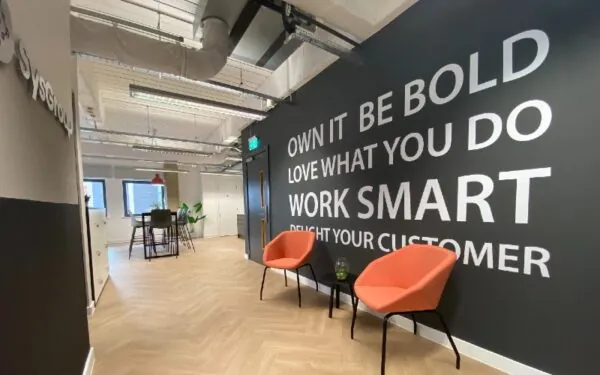The arrival of COVID‐19 sparked a mass move to remote working, with businesses scrambling to connect staff who suddenly found themselves working from sofas and kitchen tables.
“The world has shifted and there is no going back,” says James Penny, chief technology officer at managed services provider SysGroup. “Eighteen months ago, many people didn’t know how to jump on a Teams or Zoom call and then almost overnight, laptops, webcams and headsets all went into short supply. Now, pretty much everyone is comfortable with using technology for remote working.
“Multiple models have emerged: some businesses are continuing with remote working; others want their staff back in the office as much as possible; and some are asking their people to return to the office for two or three days a week.”
Companies of all shapes and sizes are now accustomed to working on the move, daily Teams meetings and virtual networking. As the world opens up again, can we really go back to the way things were?
A hybrid approach is being advocated by Dawn Coker, chief executive officer at Birkenhead-based R&D tax specialist Access2Funding. “Rather than stepping back into a traditional working model, employers should embrace fresh solutions,” she says.
“As employers, it is tough to weigh things up. On the one hand, there are lots of people who can’t wait to get back into the office; some would prefer to stay at home; and for others, a combination of remote work with time in the office can create the perfect mix of productivity and collaboration.
“Creating a strategy that facilitates the needs of the individuals, whilst not impacting output, is important. What is key, following a pandemic, is that employees are engaged and able to voice their opinions and concerns on a potential return to office working.”
Perform and achieve
Chwarae Teg, founded in 1992, is committed to gender equality in Wales. CEO Cerys Furlong says the rise of technology extended the charity’s reach. “We have been able to offer virtual support to women and businesses. Technology has given us the visibility we require to enable us to perform and achieve,” she says. “It also allowed us to streamline back‐of‐house systems, which reduced our people costs.”
When its 76 employees transitioned to working from home, the process was smooth. “We were actually ahead of the game in that we had made the decision to move to home‐based working and shut our three project offices at the end of March,” explains Furlong. “We will remain home‐based as this will allow us to employ the best and not be limited by geography.”
Chwarae Teg partners with Liverpool‐headquartered SysGroup, which also has bases in Newport and London ‐ and recently opened a base in Manchester ‐ for its technology solutions. “SysGroup helped us roll out new hardware with a simple one‐touch approach for staff – this was extremely useful as we have staff based across all of Wales and further afield,” adds Furlong.
https://businesscloud.co.uk/blog/2021/08/31/gig-economy-and-defi-will-transform-how-people-live-and-work/
Microsoft’s Work Trend Index research for 2021 indicates that almost three‐quarters of workers want flexible remote work options to continue, while more than 65 percent are craving more in‐person time with their teams.
“The data is clear: extreme flexibility and hybrid work will define the post‐pandemic workplace,” the report states. It also found that too many video meetings using tools such as its own Teams software can be detrimental to staff health and productivity.
No ‘one size fits all’
Each business in its own right must find out what its hybrid model looks like, according to SysGroup CEO Adam Binks. “There isn’t a rulebook that you can pull out and say ‘Monday, Wednesday, Friday, you’re in the office, and Tuesday, Thursday you’re at home,” he says. “That sort of stringent routine won’t work because you’re never going to know who will be where or when.
“But it’s also important that you get people back in the office ‐ and that people do want to come to work in the office ‐ because that innovation, that collaboration, will never happen the same over web conferencing. Things like bumping into a colleague in the office and getting that water cooler chat ‐ the value attributed to that is impossible to put a number on, but it’s really important to every kind of business.
“Bringing your people together creates a drive and energy to grow the business. It’s about getting that balance right between home and office‐based working.”
CTO Penny says project‐based creative work in particular is smoother when people come together. “Operational meetings can work really well on Teams, but when you’re brainstorming you need to spend time face to face and whiteboarding,” he says.
“If you are creating a document then working remotely is fine: you don’t need to necessarily interact with anybody else. But where you’re building new solutions and breaking new ground then working remotely is less effective.
“If a team is having a quick agile stand‐up to check on the progress of projects, there is no compelling reason to go to an office. But if you’re then going to take a project apart, look at the opportunities and challenges, then you can’t beat being face‐to‐face in a room with a whiteboard so you can explore and share ideas.”

Chwarae Teg’s Furlong adds: “We are using the ‘adopt, abandon, amend’ approach with what we have learnt whilst working through the pandemic. We see the need to have more staff get‐togethers as we won’t be having those water cooler moments, but realise how important it is to keep connections with staff and that one size does not suit all.”
Ask your staff
Indeed, every business is different ‐ and Access2Funding’s Coker agrees that speaking to staff is crucial to finding the right approach. “I circulated a staff wellbeing survey to gauge how employees felt about a potential return to the office and, as expected, opinions were varied,” she says. “Hybrid working is most likely going to be the strategy of choice for many in the near future, including us, which will hopefully provide a happy medium and minimise the impact of putting employees through another stressful time in their working lives.
“Despite technology allowing employees to collaborate and socialise online, there is no substitute for physical interaction.”
She advises: “Consider creating more flexible workplaces, such as hot‐desking onsite so employees can hop in and out of the office with their laptops, whenever they like.
“Highlight the positives – has your company thrived as a result of remote working? Has greater flexibility meant productivity increased? Has a reduction in time spent commuting or attending client meetings meant more time spent on tasks?
“Equally, do not dismiss the negatives, but show awareness and provide ways to resolve any challenges to a hybrid working model. You can’t please everyone, but it is paramount that we as business leaders develop a healthy balance between the office and remote working.”
Location-independent
SysGroup’s solutions are designed to be ‘location‐independent’. “You can’t build a solution now that demands people have to be in a physical location. It’s just not going to happen going forward,” says Penny.
“If we deploy an application in our Enterprise Cloud, or, if necessary, in the Public Cloud, we need to make sure it is available from anywhere.
“We need to support our customers to be flexible: our customers need to not worry about where their people are going to be ‐ we’ll just make sure they can access any data and applications they need to make them effective, wherever they are. SysGroup will manage endpoints for you and your overall application strategy, so that all you need to focus on is your business and not worry about whether James or Jenny can access something because he or she is working from home.
“We need to focus on building a ‘location-independent’ approach to all IT solutions – this allows us to work alongside whatever the customer set needs to do.”
https://businesscloud.co.uk/blog/2021/04/28/is-this-the-end-of-the-office-tech-leaders-discuss-covid-19-changes/
COVID-19

